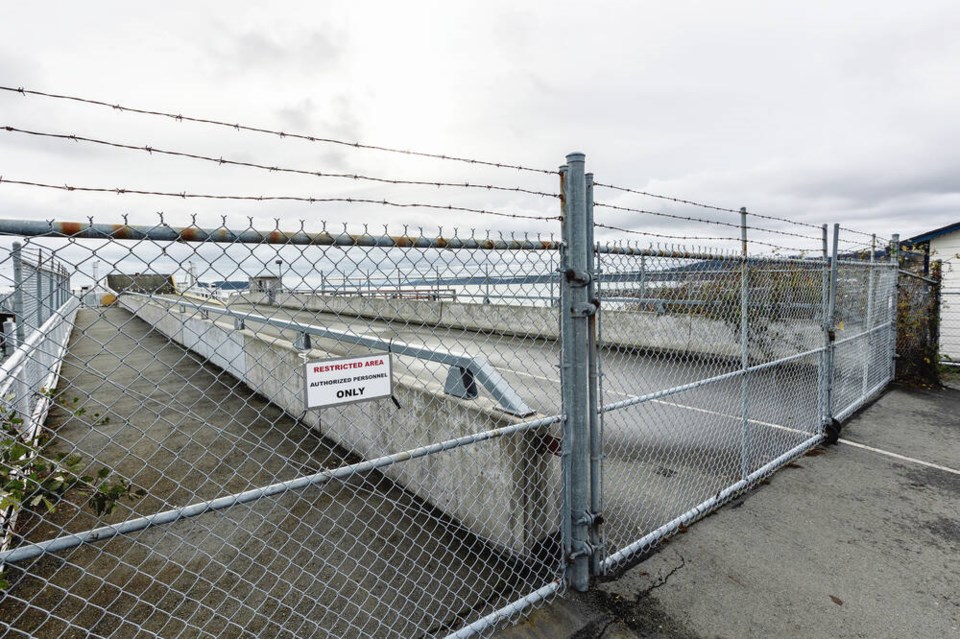Weeds are starting to grow through the cracks in the pavement at the Sidney-Anacortes ferry terminal.
A tennis ball, presumably thrown for a dog, is stranded in a puddle on the wrong side of the security fence. Who knows when it will be freed?
Not any time soon. The resumption of the century-old ferry run, dormant since 2019, remains on hold.
“The Anacortes-Sidney, B.C. route is expected to remain out of service until at least this coming summer,” a Washington State Ferries spokesman said this week.
Why? Largely, it’s because the Washington system is plagued by the same crew shortages as B.C. Ferries. It’s tough to find replacements for seasoned mariners as they retire.
In addition, though, our neighbours are hamstrung by a shortage of vessels. Their creaky fleet has been allowed to rust out.
This was detailed in a Washington State Ferries report on its recovery efforts this year. “WSF had 24 vessels five years ago, but due to vessel retirements there are now only 21 active vessels in the fleet — an insufficient number for reliable service even without the pandemic. Another vessel, the Tillikum, is due to be retired in 2023. In addition, the fleet is aging, with more than half of the vessels over 30 years old, including three over 50 years old.”
The legislature and governor have committed funding to build up to five hybrid electric ferries, but the first isn’t expected before 2026.
If it’s any comfort to our southern neighbours, our northern ones are in the same boat (as it were), wrestling with rejuvenation of the state-run Alaska Marine Highway ferry system’s aging fleet.
Contrast that with B.C. Ferries. The corporation might not have enough people to steer its vessels, but at least it has vessels to steer.
That’s one of the consequences of the provincial government’s sort-of privatization of the ferry service in 2003. Prior to that, capital-spending decisions were skewed by politics, with B.C. Ferries fighting everyone else in the provincial public sector for elbow room at the funding table.
“We had to line up behind universities, schools and hospitals, and you don’t win that battle,” is the way then-CEO Mike Corrigan put it in 2013.
Once semi-free to plot its own course, the corporation embarked on an extensive replacement program. It has brought 19 vessels into service since 2003. It plans to build 15 more, including seven major ones, over the next dozen years.
The Washington system, by comparison, continues to be susceptible to political tides, ones that have often left the Sidney service in danger of running aground. That was the case in both 1977 and 1997, when it took strenuous efforts by officials in both Sidney and Anacortes to keep the run afloat.
It didn’t help that the whole system was thrown into crisis in 1999 when residents from across the state voted out the automobile excise tax that provided Washington State Ferries with much of its funding. (Think of what the results would be if voters in Penticton and Prince George were asked: “Do you want to pay a car tax to pay for ferries on the coast?”)
Then came the pandemic and the suspension of non-essential cross-border travel in March 2020 — though in truth, the rapidly rusting Washington system was already having trouble maintaining the once-a-day (twice in summer) Sidney-Anacortes service before shutting it down for what was supposed to be its usual three-month winter hiatus at the end of 2019.
For years, there were two ferries capable of sailing the route, but when the MV Elwha gave up its will to live in the summer of 2019; that left only the 124-car, 1,100-passenger MV Chelan. When it, too, broke down that November, the Sidney run had to be abandoned for four weeks.
These days, the Chelan is confined to U.S. waters as the Washington system recovers from its COVID funk.
The Sidney run is eighth, and last, on the priority list of routes. “Ongoing staffing challenges have us restoring domestic service before anything international,” is the way Ian Sterling of Washington State Ferries put it this week.
That’s why, when the Coho and Clipper Victoria-U.S. runs resumed as pandemic restrictions eased, the Sidney terminal stayed closed.
Washington State Ferries first said it hoped to resume service last fall, then bumped that to this spring, then ruled out 2022 altogether. Fingers crossed for next summer, maybe.
>>> To comment on this article, write a letter to the editor: [email protected]



